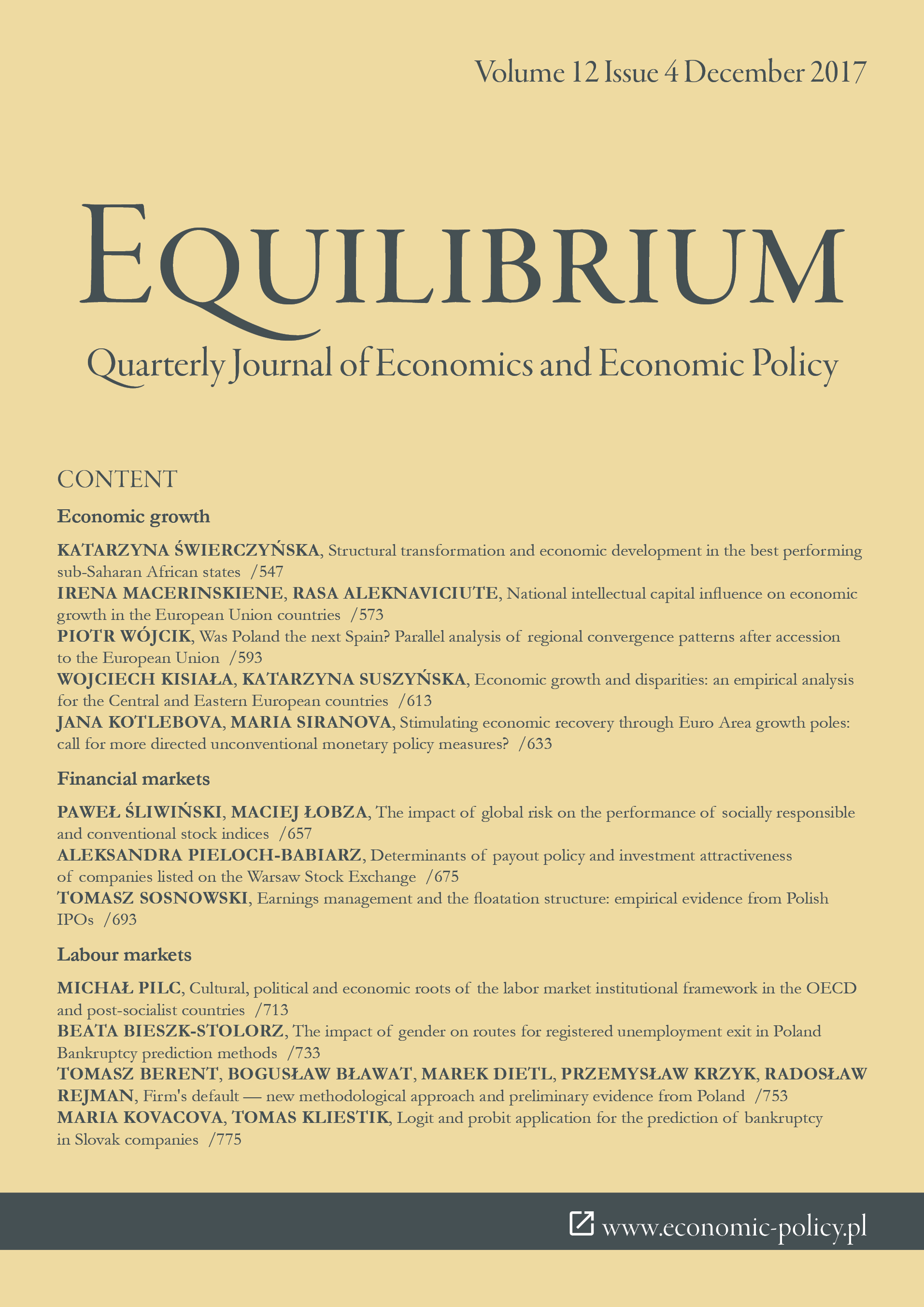Stimulating economic recovery through euro area growth poles: call for more directed unconventional monetary policy measures?
DOI:
https://doi.org/10.24136/eq.v12i4.33Keywords:
growth pole, unconventional monetary policy, network analysisAbstract
Research background: Transfer of newly created money through unconventional monetary measures follows the official European Central Bank distribution key. Yet, it does not take into account the ability of individual countries to drive growth process in other economies. Money spent to boost domestic credit provisioning in growth pole-like economies is more likely to spill over to other adjoined economies and help them to recover, even in the presence of depressed domestic demand and/or overleveraged domestic banking sector.
Purpose of the article: This paper reports growth pole scores for 19 euro area countries, and compares it to the official distribution key used to transmit newly created source of funding.
Methods: We modify the procedure developed in World Bank (2011) for growth pole com-putation in order to account for strength of linkages connecting member states.
Findings & Value added: Our results suggest that the official distribution key might not be completely optimal once looking at the growth pole scores. Countries small in economic size (Baltic states, Slovakia and Slovenia) would benefit from a more differentiated distribution, as they strongly outperform their benchmark set by the official distribution key. On the other hand, big euro area economies do not achieve the levels used in official distribution key, taking into account their growth pole potential for other euro area economies.
Downloads
References
Arcand, J. L., Berkes, E., & Panizza, U. (2015). Too much finance? Journal of Economic Growth, 20(2). doi: 10.1007/s10887-015-9115-2.
Beck, R., Georgiadis, G., & Straub, R. (2014). The finance and growth nexus revis-ited. Economic Letters, 124(3). doi: 10.1016/j.econlet.2014.06.024.
Cecchetti, S. G., & Kharroubi, E. (2015). Why does financial sector growth crowd out real economic growth? BIS Working Paper 490.
Dabla-Noris, E., Guo, S. Haksar, V., Kim, M., Kochhar, K., Wiseman, K., & Zdzienicka, A. (2015). The new normal: a sector-level perspective on growth and productivity trends in advanced economies. IMF Staff Discussion Note.
Gennaioli, N., Shleifer, A., & Vishny, R. (2012). Neglected risks, financial innova-tion, and financial fragility. Journal of Financial Economics, 104(3). doi: 10.1016/j.jfineco.2011.05.005.
Gros, D. (2012). Macroeconomic imbalances in the Euro area: symptom or cause of the crisis? CEPS Policy Brief, 266.
King, R., & Levine, R. (1993). Finance and growth: Schumpeter might be right. Quarterly Journal of Economics, 108(3). doi: 10.2307/2118406.
Kotlebova, J., & Siranova, M. (2014). Structure of the EU28 plus Ukraine econom-ic region from the growth pole theory perspective. Region Direct, 7(1). doi: 10.2478/regd-2014-0002.
Levine, R. (2005). Finance and growth: theory and evidence. In P. Aghion & S. Durlauf. Handbook of Economic Growth. New York: Elsevier.
Perroux, F. (1950). Economic space: theory and applications. Quarterly Journal of Economics, 64(1). doi: 10.2307/1881960.
Sahay, R., Čihák, M., N?Diaye, P., Barajas, A., Bi, R., Ayala, D., Gao, Y., Kyobe, A., Nguyen, L., Saborowski, C., Svirydzenka, K., & Yousefi, S. R. (2015). Re-thinking financial deepening: stability and growth in emerging markets. IMF Staff Discussion Note, SDN/15/08.
Siranova, M. (2015). European banking network in light of the single supervisory mechanism from the network analysis perspective. Financial Assets and Investing, 1. doi: 10.5817/FAI2015-1-2.
Timbeau, X. (2014). Independent annual growth survey 2015: Third Report. iAGS. December. Retrieved from http://www.iags-project.org/documents/iags_report 2015.pdf
World Bank (2011). Global development horizons 2011. Multipolarity: the new global economy. Washington: World Bank (IBRD).






